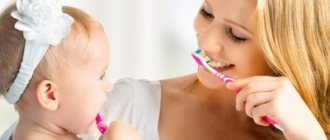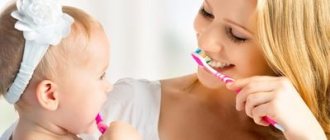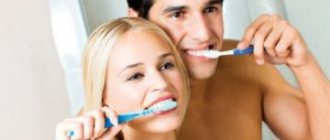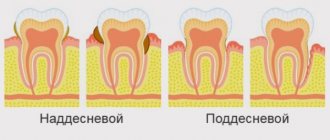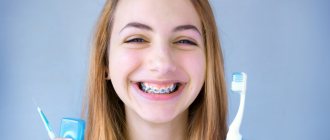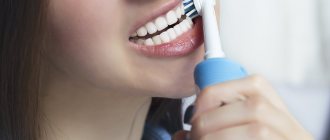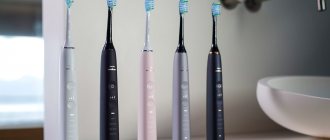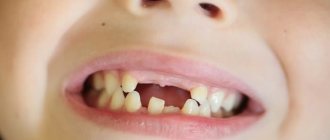Not all parents know how to properly brush their children’s teeth, but The condition of the erupted permanent teeth depends on the quality of care for baby teeth.
. To protect your child from problems with molars, incisors and canines, it is necessary to teach him to brush and rinse his mouth after the very first tooth erupts.
Features of the structure of milk teeth
Baby teeth form in the sixth week of fetal development. Normally there are 20 of them:
- 8 molars;
- 8 incisors;
- 4 fangs.
Temporary teeth consist of the same tissues as permanent teeth:
- dentin (in temporary teeth it is softer and less mineralized);
- enamels;
- pulp.
However, primary incisors, canines and molars have features:
- low crowns;
- large distance between crowns;
- long thin roots that dissolve before the temporary tooth falls out and the permanent tooth erupts;
- thin enamel - only 1 mm;
- wide channels.
The structure of baby teeth is only slightly different from permanent teeth, so they no less need proper care. You can start brushing your child’s teeth after the very first incisor has erupted.
. Early training in hygiene will be an excellent prevention against many dental diseases that can affect the primary incisors, and then the rudiments of the permanent ones formed under them.
If you don’t care for your baby’s teeth or care for them incorrectly, your baby will have to visit pediatric dentists already in the first three years of life. Or he may tolerate drilling rotted teeth with a bur, which is painful and unpleasant for a small child, even with high-quality anesthesia.
Subsequence
The order in which teeth appear may vary, which is rare and is not considered pathological. For some boys and girls, the upper incisors appear first, rather than the lower incisors as usual. But basically the sequence of teething in children is as follows (teeth appear in pairs):
- lower central incisors;
- upper central incisors;
- upper lateral incisors;
- lower lateral incisors;
- first upper molars (molars);
- first lower molars;
- upper canines;
- lower canines;
- second lower molars;
- second upper molars.
By the age of 2.5–3 years, the child has a full set of baby teeth: 10 on each jaw. After about 4–6 years, the roots begin to dissolve, the teeth lose support and fall out in the same order in which they erupted.
As the jaw and facial bones grow, spaces form between the primary teeth. This provides space for permanent, larger teeth to emerge, which erupt from 5 to 15 years of age.
How to properly clean a baby's mouth
Immediately after being discharged from the hospital, you need to start wiping the newborn baby’s gums with a thick gauze swab dipped in water. You can also wet the tampon in:
- chamomile infusion, if the baby does not have constipation;
- bactericidal infusion of sage;
- St. John's wort decoction, as this plant strengthens the gums;
- anti-inflammatory decoction of calendula.
It is not recommended to use decoctions and infusions of herbs to treat the oral cavity of a baby more than 2-3 times a week, as their abuse can lead to allergic reactions.
Maintaining hygiene, which involves treating the oral mucosa with a gauze swab, is necessary for both newborns who are breastfed and those children who are fed artificial formula. Breast milk does not clean the oral cavity, but pollutes it. If you do not sanitize your baby’s mouth after feeding, then pathogenic bacteria will begin to multiply in it, which can lead to infection of the tooth enamel.
At what age should a child start brushing his teeth?
You need to start brushing your baby's teeth from the moment they begin to erupt.
At first, it is better to perform manipulations without paste, carefully treating not only the first tooth, but also the gum itself. You can use a special soft baby brush or a silicone pad that is placed on the parent’s finger. The last device will serve not only as a brush, but also as a gum massager, which will ease the pain from teething.
You should act carefully during the cleaning process, since the gums near the cutting tooth are inflamed and painful, so infants may react poorly to the hygiene procedure. But you cannot refuse it: during teething, local immunity deteriorates, so the risk of infection of the enamel increases.
More details about caring for the oral cavity of a newborn are described in the video:
Teething
It is often difficult for parents to determine whether their baby is cutting a tooth or whether his reaction is caused by other reasons. Teething may be indicated by excessive salivation, redness of the gums, irritation of the skin around the mouth, diarrhea, and frequent awakenings at night. If your baby happily allows you to put your finger in his mouth and massage his gums, but does not allow you to look into his mouth, this is one of the signs of teething. In some children, teeth erupt evenly from month to month, while in others, sharp bursts are interspersed with pauses. Sometimes in a week 4 tubercles appear at once, indicating the imminent appearance of new teeth; in this case, you will have a particularly troublesome time.
The teething process can be disturbing and irritating for your baby. When temporary chewing teeth are cut, some babies experience very severe pain and their gums become swollen. You can relieve your baby's discomfort by using a cold compress in the shape of a dental arch. Breaking teeth make the baby want to chew on something or someone. He needs something hard to scratch his irritated gums on. During this period, teeth marks may appear on the railings of the crib, and the baby may bite and squeeze your finger and even your breast with his gums during feeding. Give your baby something cold and hard to chew on - this could be a refrigerated cookie or a special chew ring.
As for food, the situation here is different. For some children, teething does not affect their nutrition in any way, some require more food, but there are also children who refuse to eat during the teething period. The most important thing is not to panic, the baby will not remain hungry: as soon as the pain goes away, the child will make up for lost time. Try to ease your baby's suffering by using a cold spoon to feed.
Be sure to buy special “teethers” at the pharmacy (preferably with pimples and a special gel inside). Before giving them to your child, you can put them in the refrigerator for 20 minutes - the effect will be better. If a child has a high fever and it is clear that he is in pain, give him an antipyretic, but always paracetamol-based. When teething, it is also recommended to lubricate the gums with special gels. One of the most famous is “Kalgel”, although its effect lasts for a maximum of half an hour. "Solcoseryl" is more effective in this sense. However, these drugs should not be used too often: a maximum of 6 times a day, with breaks of at least 3 hours.
During the period of teething, the child especially needs special care for the oral mucosa. Biologically active components from toothpastes should help relieve inflammation and the accompanying pain symptom. They cannot be found in regular toothpastes, so the optimal choice during this period is ROX toothpastes. In particular, toothpaste “ROKS baby aroma of linden from 0 to 3 years”: in addition to the fact that it does not contain fluoride, fragrances and sodium lauryl sulfate and is safe for the child’s body when swallowed, it includes high concentrations of xylitol, which has a pronounced anti-caries effect. In addition, the paste contains linden extract, which has a mild anti-inflammatory effect, necessary for teething.
How to properly brush children's teeth
There are several general rules for high-quality teeth cleaning, depending on the age of the baby:
- A child under one year old should brush his teeth using a special silicone pad, which is fixed on the parent’s index or thumb.
- After a year, you can use a brush with silicone bristles and a special limiter, gradually switching to classic models.
- From the age of three, a regular brush with soft bristles is used. It is important that its surface is covered only by two dental crowns, otherwise the hygienic procedure will not be effective enough.
A baby brush needs to be changed every 3-4 months. If the service life has not yet expired, but the brush has already become rough around the edges, you should change it, since pathogenic bacteria can begin to form and multiply between the bristles.
How to brush the teeth of a child under 1 year old
Six months is the age when parents should start brushing their child’s teeth every day.
From 6 to 12 months, children are cutting teeth, so during this period it is necessary to sanitize their oral cavity very carefully. The baby cannot yet take part in the hygiene procedure, but can already express his dissatisfaction with sounds and gestures, so the adult should focus not only on the dental cleaning technique, but also on the baby’s sensations.
How to properly brush your first teeth
Key cleaning rules:
- the necessary movements should be sweeping: from the root to the top;
- the finger with the silicone attachment should be in the child’s mouth at an angle of 45 degrees to the gums;
- when processing chewing surfaces, the finger with the nozzle is positioned horizontally and cleans the crown with progressive longitudinal movements;
- The inner surface of the teeth is cleaned with short, quick movements;
- The side teeth can be cleaned using circular movements.
There should be about 10–15 movements per tooth. During the procedure, it is necessary to clean not only the dental enamel, but also the inner surface of the cheeks, tongue and gums. You can also brush your one-year-old child's teeth using special dental wipes, which can be purchased at the pharmacy.
Why you need to teach your child to brush their teeth earlier than one year
You should start brushing your baby's baby teeth when the first incisor appears or even before it fully erupts. Complete oral care will help:
- form the correct bite;
- It is good to clean the oral cavity from cariogenic bacteria;
- prevent various diseases, including caries.
How to brush teeth for children over one year old
A child over 1 year old can purchase their first toothbrush with silicone bristles. It costs more than a regular one, but such a waste of money is justified: a brush with silicone bristles will not injure the child’s teeth and will help to thoroughly clean the gums and cheeks. You can use it to clean even your child’s first teeth. However, such brushes quickly become unsuitable for safe use, so they should not be used for a long time.
Rules for caring for a children's toothbrush with silicone bristles
In order for the silicone brush to last longer, you must follow the following rules for its operation:
- Do not boil or even simply pour boiling water over the brush;
- After each use, you should wash it with soap (baby, tar, laundry).
The brush should not be placed in a case; it should be stored in a closed cabinet, in a glass, separately from the brushes of adult family members.
How to choose the right toothpaste for your child -
To be honest, I have almost no idea how ordinary parents can navigate the abundance of conflicting information about the dangers and benefits of various children’s toothpastes, because up to 99% of all reviews about toothpastes on the Internet are hidden advertising or anti-advertising. In addition, the Internet has long turned into a garbage dump - after all, half of the sites contain absolutely irrelevant information that has not been updated for decades. Here are some examples.
Women's forums and blogs are filled with shocking articles about the dangers of parabens (preservatives) and sodium lauryl sulfate (SLS), about which various horror stories have been written. For example, that parabens are carcinogenic and accumulate in tissues, destroying the lungs and brain, and also that they can disrupt the endocrine system, exhibiting estrogenic activity. Regarding carcinogenicity and organ toxicity, this is generally not true (clinical studies), but as for estrogenic activity, this is a very interesting topic.
The fact is that parabens are a whole group of substances, which includes methylparaben, ethylparaben, propylparaben, isopropylparaben, butylparaben, isobutylparaben, and benzylparaben. So, toothpastes usually use only parabens with small chain sizes (these are methylparaben and ethylparaben). According to authoritative research, short-chain parabens do not have estrogenic activity at all, but long-chain parabens (for example, isobutylparaben) do.
But the most interesting thing is that the estrogenic activity of isobutylparaben is 240,000 times! less than estradiol (this is the most active female sex hormone of the estrogen group). Therefore, it may not have any clinical significance. But why it is really not advisable to include parabens in children’s toothpastes is due to possible irritation of the mucous membrane or the development of allergic reactions on the oral mucosa (according to statistics, this occurs in approximately 4% of children).
The same applies to the harm of sodium lauryl sulfate (SLS), the whole fault of which essentially lies only in accelerating the desquamation (desquamation) of the epithelium of the oral mucosa. Therefore, if a child uses toothpaste with SLS and has predisposing factors to the development of stomatitis or thrush, the frequency of repeated cases of stomatitis, as well as their severity, may be higher (compared to children who use toothpaste without SLS) . You can read about this in an authoritative study at the link (source), but if you don’t know English, use a browser translator.
Overall, I hope you will think about this information and begin to think more critically about information on forums and blogs. And we argue our point of view - not only with the dental education of the author of the article (with more than 20 years of experience), but also always provide links to the most authoritative clinical studies.
Now, more about choosing children's toothpaste -
On our website there is a separate article with a rating of children's toothpastes (for 2022). But in this section we would like to talk about the strategy for choosing toothpaste for children of different ages - from 0 to 2 years, from 2 to 6 years, and from 6 to 12 years. The fact is that there is a lot of outdated information on the Internet, and we want to tell you about the latest recommendations from the most reputable medical organizations. Those. everything we discuss below is recommended by the following organizations:
- "WHO" (World Health Organization),
- "EAPD" (European Academy of Pediatric Dentistry),
- "AAPD" (American Academy of Pediatric Dentistry),
- "AAP" (American Academy of Pediatrics),
- "StAR" (Russian Dental Association), etc.
The main question for parents - with fluoride or without fluoride
Fluoride-containing toothpastes have high anti-caries activity (unlike calcium-containing toothpastes without fluoride), however, excess fluoride intake into the body increases the risk of developing dental fluorosis. Fluoride cannot penetrate the oral mucosa, and its entry into the body during brushing is associated exclusively with involuntary swallowing of toothpaste. The latter is possible in children under 4-6 years of age, because At this age, children have not yet developed a fully controlled swallowing reflex.
But in order for a child to develop dental fluorosis, he needs to swallow almost half a tube of toothpaste every day . But this is impossible, because The recommended amount of toothpaste is much less. And therefore, swallowing fluoride toothpaste can be dangerous - only if you live in a region with a high level of fluoride in drinking water, or if you feed your child nutritional formulas enriched with large amounts of fluoride. If these 2 main factors are absent, then swallowing a small amount of fluoride toothpaste every day will never lead to the development of fluorosis.
→ Regions with high levels of fluoride in drinking water
In short, these regions include some areas of the Moscow region, Kirov, Vladimir, Samara, Ryazan, Tver, Irkutsk, Yaroslavl, Kaluga, Kemerovo regions, as well as Karelia and the Republic of Mordovia (source - see the link above). The ideal fluoride content in tap water is 0.7 mg/l, and exceeding this figure to 1.0-1.2 mg/l already statistically significantly increases the risk of developing fluorosis.
It is also important to consider that water filtration systems operating on the principle of reverse osmosis reduce the fluoride content in water by approximately 84%, and carbon filters by at least 81% (this was proven by research by Brown MD and Aaron G., publication in the journal " Pediatr.Dent" for 1991). Therefore, even if you live in regions with a high level of fluoride in water, your child’s fluoride intake may be within normal limits (the main thing is that you do not forget to regularly change the cartridges for your filter, and also do not give it bottled or spring water).
Table 1 is the recommended total daily fluoride intake for children 0 to 19 years of age. Link to scientific publication (Source - US National Academy of Sciences).
What else is very important. The risk of developing fluorosis only exists in children between 0 and 6 years of age, with the most important period being between 0 and 2 years of age. Excess fluoride consumption after 6 years can no longer lead to the development of fluorosis in permanent teeth. Therefore, regarding the prescription of fluoride toothpaste to a child from 0 to 2 years old, it is better to consult your dentist to be on the safe side.
If your child does not have carious teeth (or there are only isolated cases of caries), in this case you can safely use calcium-containing toothpastes without fluoride , but it is imperative that it contains a high dosage of xylitol/xylitol. Xylitol is a sweetener that also has anti-caries activity, although it is less than fluoride. It is best when fluoride-free paste contains a combination of several calcium compounds at once - this can be calcium lactate, calcium pathotenate, calcium glycerophosphate and hydroxyapatite.
If your child has new carious lesions regularly, then, provided there is no excess consumption of fluoride in drinking water and milk formulas, fluoride toothpaste can be prescribed even from 0 to 2 years. Previously, the concentration of fluoride in toothpastes for children of this age was only 500 ppm, but since 2022, WHO (World Health Organization), as well as all other organizations listed above, have changed the recommendations to 1000 ppm. The main thing is not to exceed the recommended amount of toothpaste.
Table 2 – recommended concentration of fluoride in toothpaste for children. This is data from a very authoritative organization - the European Academy of Pediatric Dentistry (EAPD). Link to scientific publication (source).
Therefore, it is considered safe for children 0 to 2 years of age to use toothpaste with 1000 ppm fluoride—about the size of a small pea (or a large grain of rice). For children from 2 to 6 years old, the volume of toothpaste with 1000 ppm fluoride should be about the size of a large pea. An important point - if your children's toothpaste contains only 500 ppm of fluoride, then to achieve exactly the same content of fluoride ions - you just need to use 2 times the volume of toothpaste than stated above.
Volume of toothpaste with fluoride 1000 ppm (up to 2 years, and after 2 years) –
Toothpastes if your child has frequent stomatitis -
In early childhood, children experience fairly frequent outbreaks of various forms of stomatitis on the oral mucosa. You can, of course, regularly treat aphthous and herpetic forms of stomatitis. But it is much more effective to use special toothpastes to prevent stomatitis, which increase the protective properties (local immunity) of the oral mucosa - due to the content of lactoperoxidase, lactoferrin, glucose oxidase and lysozyme. These enzymes are part of “SPLAT Junior” and “SPLAT Baby” (Fig. 12-13).
Can a child use mouthwash?
As a general rule, mouthwashes are not recommended for children under 6 years of age. It is at this age that children develop the skill of not swallowing liquids when necessary and spitting them out. It is important to note that mouthwashes are not a substitute for traditional teeth brushing. They in no way help to clean your teeth, but they help strengthen your teeth enamel due to their fluoride content.
Toothpastes for one-year-old children and infants
To start brushing children's teeth using toothpaste, it is not necessary to wait until the child is one or three years old. Most toothpastes are indicated for children over 2 years of age, however, there are a number of manufacturers whose product lines include good fluoride-free toothpastes suitable for children under one year of age. They are completely harmless and can be swallowed. Such products can be found among the brands:
- ROCS
- Elmex.
- Splat.
- Lacalut.
Each toothpaste indicates at what age it is approved for use - you need to brush your child’s teeth only with a product that is not contraindicated for him and is suitable for comprehensive care of children’s teeth.
When starting to brush the teeth of a child under one year old using toothpaste, you need to monitor his reaction. Some babies may develop allergies, so at the first symptoms of a rash or an incomprehensible cough, you should stop using the paste and show your baby to a doctor.
Pediatric gingivitis
As a result of plaque accumulation, your baby may develop gingivitis. When cleaning your child's mouth, pay attention to the condition of his gums. Their redness and swelling are a sign of the onset of the disease. Another symptom is bleeding gums, which you may notice after brushing your teeth.
Regular thorough oral hygiene and professional teeth cleaning at a dental clinic can help you get rid of childhood gingivitis. If the necessary measures are not taken in time, periodontitis may develop, and then the child will require more serious treatment, including surgery.
To keep your baby's gums and teeth healthy, start regular oral care immediately after birth and be sure to take your baby to the dentist before he or she turns one.
Teeth brushing technique with toothpaste
You can start brushing your teeth with toothpaste when the child’s first incisor appears, the deadline is one and a half years.
You shouldn’t wait until he develops caries due to lack of proper care.
Brushing procedure with toothpaste:
- a certain amount of paste is applied to a pre-moistened brush;
- the brush is brought at a right angle to the crowns;
- The tooth surface must be cleaned using sweeping movements: from the roots to the tops;
- The inner dental surface is cleaned with short movements, the brush is placed at an angle of 45 degrees;
- the cutting and chewing surfaces of the crowns are processed at the very end;
- after completing the procedure, you should rinse your mouth with water;
- The approximate duration of each cleaning is 2–3 minutes.
2–3 years old is the age when you need to start teaching your child to brush their teeth on their own.
How to teach a child to brush their teeth
Many children under 1 year old, and sometimes older children, do not want to brush their teeth, expressing their dissatisfaction in every possible way. In this case, it is necessary to attract their attention to the hygiene procedure using one of the following methods:
- buy a bright brush with your favorite cartoon character and toothpaste with a pleasant fruity taste;
- invite your child to brush the teeth of his toys;
- brush your teeth with your child and compete with him in the quality and speed of brushing.
Each parent independently decides at what age to start brushing their child’s teeth and whether to use toothpaste, but delay can negatively affect the baby’s health. Parents should not only brush their children’s teeth, but also teach them how to properly care for their mouth on their own.
Dr. Komarovsky talks in more detail about children’s teeth, caring for them and teaching a child to brush:
